Possible Suez Canal Extended Closure Bad for Oil Prices
Alternative routing electives are lengthy and may be risky, increasing the cost of transportation and timely delivery schedules.

October marks the beginning of the fourth quarter, with oil pricing for WTI at $87.64/barrel and Brent at $90.69/barrel as of this writing. “Crude oil prices have been primarily driven by the anticipation of additional cuts from major oil-producing nations, Russia and Saudi Arabia,” notes Sugandha Sachdeva, executive and chief strategist at ACME Investment Advisors. He adds that the steady increase in U.S. oil production could limit additional significant gains in pricing.
Russia announced it has committed to a 300,000 barrels/day (bpd) reduction in September, coinciding with Saudi Arabia’s reduction of 1 million bpd — with both extending the cuts to the end of the year.
“The impact these cuts will have on inflation and economic policy in the West is hard to predict, but higher oil prices will only increase the likelihood of more fiscal tightening, especially in the United States, to curtail inflation,” says Jorge Leon, senior vice president of Rystad Energy.
Adding to concerns regarding supply and pricing is the looming possibility of an extended closure of the Suez Canal. Some 50 ships per day, or approximately 10 percent of global trade, sail through the canal each day, carrying everything from food and electronics to chemicals, ore and petroleum.
Alternative routing electives are lengthy (more than 13 days) and, in some cases, risky, increasing the cost of transportation and timely delivery schedules. The large container ships — the super-mega max container ships — can consume 100 to 150 tons of fuel a day. That’s approximately $80,000 a day in fuel and an extra 10-plus days of steaming time. This does not include added insurance costs.
A lengthy blockage would affect the pricing of oil, increasing the cost of gasoline. All countries should be concerned about this possibility and the impact on their supply chains.
Also, the congestion at the Panama Canal due to low water and the inability to handle the super-mega ships is exacerbating world trade shipping costs and timely deliveries.
This is another challenge to the supply chain operations we see across the board.
The escalation of events in the Mideast and Pacific emphasizes serious concerns for U.S. supply chain stability that impact the availability of offshore PVF products (i.e., fittings, flanges, pipe, valves and other raw materials) particularly at high risk.
Those at risk should, if they have not already done so, prepare contingency plans contemplating worse-case scenarios, including developing domestic supply chains.
Gulf of Mexico Oil and Gas Lease Sale
The U.S. Department of the Interior’s (DOI) Bureau of Ocean Energy Management (BOEM) published the Final Notice of Sale and Record of Decision for Gulf of Mexico Oil and Gas Lease Sale 261 on Aug. 25.
As of this writing, BOEM intended to conduct the lease sale on Sept. 30, offering 13,620 blocks on approximately 73.4 million acres on the U.S. Outer Continental Shelf.
In a statement posted on the American Petroleum Institute’s website, Vice President of Upstream Policy Holly Hopkins says: “While the DOI announced a much-needed offshore lease sale … the Biden administration continues to throw up roadblock after roadblock to American energy production, prioritizing its campaign promise to stop American oil and natural gas development in federal waters over its duty to meet American’s energy needs.
“With this announcement, the administration is removing approximately six million acres of the Gulf of Mexico and adding new and unjustified restrictions on gas and oil vessels operating in this area, amounting to a lease sale in name only.”
Energy Construction Projects
On the brighter side, $82 billion (98 million tonnes per annum) U.S. liquified natural gas capacity projects, approved by the Federal Energy Regulatory Commission, await a final investment decision (FID) to proceed with startup in 2024. The concentration of activity will be in Louisiana, Texas, Mississippi and Alaska.
Equitrans Midstream expects the construction of the 350-million-cubic-feet/day Ohio Valley Connector expansion project to begin prior to year-end to target incremental capacity in-service by the first half of 2024. Equitrans expects to invest approximately $160 million in the project.
SunGas Renewables (SGR) has elected Pineville, Rapides Parish, La., for the potential construction of newly formed subsidiary Beaver Lake Renewable Energy’s (BLRE) first plant for the production of green methanol to help decarbonize the marine shipping industry.
The proposed $1.8 billion project would involve the repurposing of an existing industrial site shuttered in 2009 and include the construction of a plant designed to produce marine fuel from regionally sourced biomass. This includes wood fiber from local forest-thinning operations and carbon dioxide using SGR’s proprietary SGR System 1000 platform.
Front-end engineering and design of the BLRE plant is scheduled for completion this month, with the FID scheduled for August 2024.
Note of Caution
Pricing for the carbon-steel butt-welding fitting and forged-steel flange sector remains stable and should remain so in the ensuing quarter, barring any unforeseen disruption in the supply chain or raw material increases.
However, it is being reported that the industry is seeing an increase in the import of carbon-steel butt-welding fittings from Vietnam. If these products were produced from Chinese rough fittings. It could be an attempt to circumvent specifications barring the use of Chinese material on domestic projects funded with taxpayer funds.
Additionally, for the Vietnamese fittings 12 inches and smaller, if formed from Chinese roughs, it would be a violation of the anti-dumping orders that are and have been in force for several years.
Contractors Unable to Fill Job Openings
The skilled labor shortage continues. The Associated General Contractors of America (AGC) and Autodesk released the findings of their latest workforce survey, notes the Engineering News-Record (https://bit.ly/485Cs44):
“The results were similar between union and open-shop firms, between small, mid-size and large contractors by annual revenue, across regions and in different segments of construction. Altogether, 85 percent of about 1,400 contractors that responded to the survey between late July and early August have open craft positions, and 88 percent of them with open positions reported having a ‘hard time’ filling them. While fewer had salaried positions open, a similar percentage reported difficulty in filling those openings.”
For 68 percent of contracting companies unable to fill job openings, the most common issue is the lack of qualified candidates.
“These shortages are adding to the impacts of supply chain disruptions that have made it difficult to get material delivered on time and are driving up the cost of those materials,” explains Ken Simonson, AGC’s chief economist.
PVF Roundtable News
The PVF Roundtable continues to work diligently to support the education and training of young associates for the PVF sector by providing scholarships through the PVF Charitable Foundation.
The next meeting of the PVF Roundtable will be the Christmas meeting on Dec. 12, 2023 (4-7:30 p.m. CDT) at Houston’s The Bell Tower on 34th, 713-868-2355.
Put this meeting on your calendar, register early, and please bring a gift or make a donation for those in need.
This year, the PVF Roundtable will exceed $2 million in total scholarships distributed by the PVF Roundtable Charitable Foundation since its inception to trade schools and universities for the development of a skilled labor force to meet the increasing demands of the PVF industry.
Distributions for the first half of 2023 were announced at the Oct. 10 meeting. Exact amounts and names of the recipients were not available as of this writing.
The PVF Roundtable Golf Tournament and TroutBlast are the major fundraising events scheduled for 2023. The Weldbend Corp., Ferguson Industrial and MRC Gobal are key sponsors of these events.
As a member of the board, and I speak for all members, we thank you for your participation in these events.
With the uncertainties in the current turbulent PVF market, networking meetings are a unique venue for you and your associates to network with your PVF peers. These events provide the platform to share information, discuss pertinent issues, meet new contacts, develop long-lasting friendships and pursue new opportunities in the industry.





